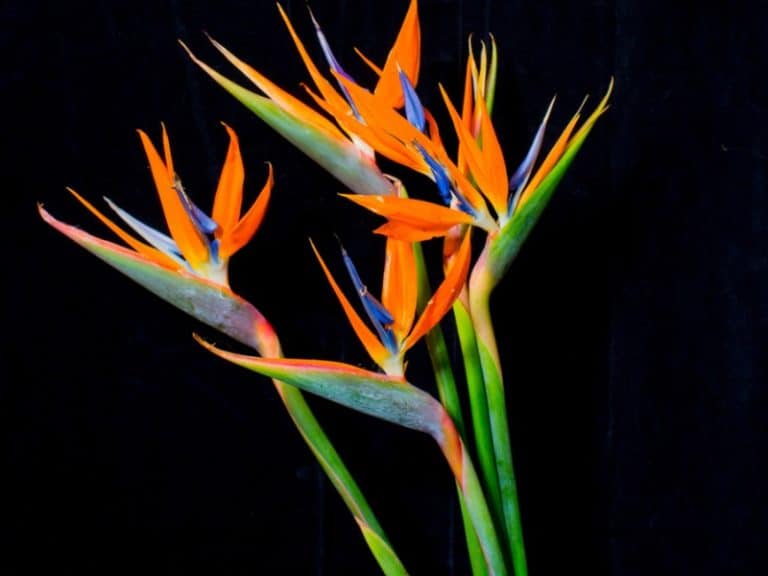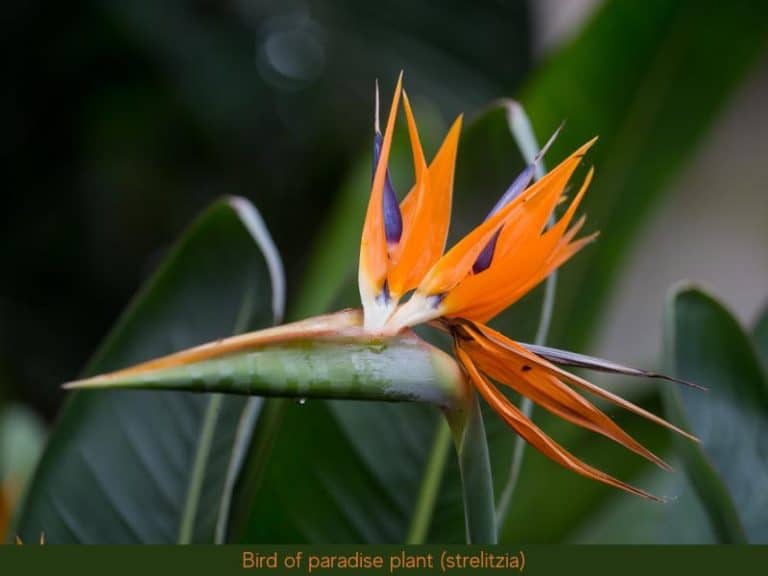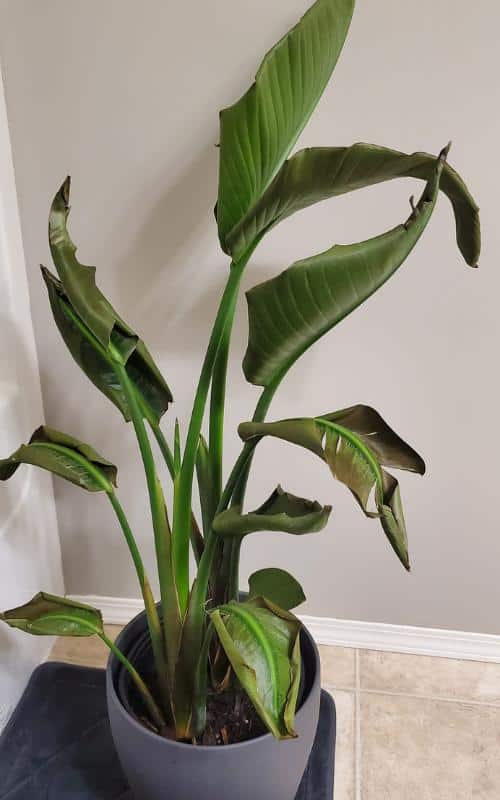Bird of Paradise Plant Varieties (Different Types of Strelitzia)
Most birds of paradise plant varieties exhibit glossy, large leaves reminiscent of the banana plant since they come from the same family. However, they belong to two different genera, Strelitzia and Caesalpinia, from which they are further classified, depending on their specific features.
Different types of birds of paradise
The Strelitzia reginae is the most popular bird of paradise plant from the genus Strelitzia, while the yellow bird of paradise is from the genus Caesalpinia. Other species grown in the United States are the white bird of paradise, the Mexican bird of paradise, and Strelitzia juncae.
Here are the 5 varieties of the bird of paradise plant:
1. Bird of paradise (Strelitzia reginae)
Strelitzia reginae, also called crane flower, is the most widespread variety of the bird of paradise plants. It’s native to South Africa and is common in the northern states of America in USDA zones 9b to 12.
The strelitzia reginae plant is commonly grown as a houseplant because of its dwarf nature. A mature crane flower can reach up to 6 feet tall and 4 feet wide, a perfect small size to fit your home, patio, office, or sunroom.
The strelitzia reginae can take up to ten years to mature before it starts blooming. However, it’s mostly kept indoors because of its waxy, luxurious, broad leaves, which add a tropical flair to a space.
The strelitzia reginae is recognized by its leaf shape and flower colors. The leaves are usually oval-shaped, glossy, and leathery. They are evergreen, making the plant beautiful throughout the year, even before it blooms.
This plant has a cluster of blue sepals and orange petals resting on its rigid stalk. The inflorescence appearance resembles the head and crown of the crane bird. The strelitzia reginae plant blooms throughout the year once it matures.
Strelitzia reginae is easy to care for when grown as a houseplant and in the garden or yard. Since it’s a tropical plant, it thrives in locations with warm winters and high humidity.
However, cold drafts stress the plant, and it might die when temperatures drop below 25oF. Placing the plant in a sunny room or near windows with indirect sunlight will help it thrive. Also, mist the plant daily to achieve a humid environment to help it grow well.
2. White bird of paradise (Strelitzia Nicolai)
The white bird of paradise plant is native to South Africa, but hardy in the USDA zones 9-11. It’s a robust species in the genus strelitzia, reaching up to 20 feet tall and 13 feet wide. However, when grown as a houseplant, it can only reach 7 feet tall.
Because of its large size, the white bird of paradise is sometimes called the giant bird of paradise.
The white bird of paradise plant has large flowers that can measure 20 inches long. The inflorescence features white sepals and a blue-green bract.
A mature white bird of paradise starts blooming after eight years.
The leaves of the white bird of paradise plant are grayish-green and resemble the banana plant’s leaves. Without the flowers, one can easily mistake the white bird of paradise for a banana tree.
The white bird of paradise thrives in humid, wet, and warm conditions. Regular watering to keep the soil moist and access to direct sunlight are necessary to grow a healthy strelitzia Nicolai.
3. Yellow bird of paradise plant (Caesalpinia gilliesii)
The yellow bird of paradise plant is a shrubbier variety in the genus Caesalpinia. It is native to Argentina and Uruguay and widespread in the subtropical and tropical regions of the United States. It’s a deciduous, evergreen shrub in warmer climates. The yellow bird of paradise is hardy in the desert regions and is thus also called the desert plant.
It has a cluster of yellow flowers with a long, red stamen. The plant blooms in summer and produces seeds after the bloom period. The seeds are contained in a pod and opened to expel them when the pod is dry.
Later, the plant reseeds itself through the expelled seeds. The leaves of the yellow bird of paradise are grayish-green with a medium texture. They resemble those of the banana plant. Additionally, they are deciduous and evergreen.
A mature yellow bird of paradise plant can reach 8 feet tall and 6 feet wide. You can comfortably grow it as a houseplant. It also blooms in summer through fall.
When caring for the yellow bird of paradise, proper location, watering, humidity, and temperatures influence its survival. The yellow bird of paradise plant prefers full sun exposure of up to 8 hours to thrive. It can, however, tolerate partial shade. Since it’s a desert plant, minimal watering once weekly in summer is suitable to keep it in good shape. Maintain temperatures between 55oF and 80oF for a healthy plant.
The yellow bird of paradise is mildly toxic to pets and humans. Its seeds and leaves can be harmful when ingested. You can plant it in a cordoned-off area outdoors or beyond the reach of kids and pets indoors.
4. Mexican bird of paradise (Caesalpinia Mexicana)
The Mexican bird of paradise is indigenous in Northern Mexico and belongs to the Caesalpinia genus. It’s hardy in the USDA zones 8-11. The Mexican bird of paradise is very cold-hardy and can survive in temperatures below 15oF. In warmer locations, this plant remains evergreen.
It can be grown as a small tree or a large shrub.
Depending on pruning methods, a mature Mexican bird of paradise can grow up to 25 feet high and 6-10 feet wide.
The leaves of the Mexican bird of paradise are oval, dark green, and fan-like. The inflorescence is a cluster of bright yellow, fragrant flowers which attract butterflies, bees, and hummingbirds. This plant blooms in spring and summer. After flowering, the Mexican bird of paradise breaks its green bean-shaped pods to expel seeds that scatter away from the main plant.
5. Strelitzia juncea
The strelitzia juncea is a unique variety of strelitzia plants. While the other varieties have large, broad leaves, strelitzia juncea has very long, thin clustered leaves resembling reeds.
Strelitzia juncea is a dwarf variety, growing to a maximum height of about 4-6 feet. Therefore, it makes a suitable indoor plant for homes and offices. Its flowers are usually pink or orange and appear from thin reeds on the leaves.
Strelitzia juncea thrives in marshy sites and needs frequent watering for optimal growth. The plant also should be kept away from cold drafts in winter. Like other bird of paradise varieties, it needs full sun exposure to thrive.
Since this plant requires good aeration, plant it in a porous pot.
Common colors of Strelitzia
The strelitzia plants’ foliages, flowers, and bracts display striking colors. The leaves are glossy, gray-green, dark green, or light green.
The bracts of the bird of paradise varieties can be dark green or dark purple with a touch of red near the edges. The flowers consist of blue sepals on the lower side, near the bract. Meanwhile, the petals’ colors are usually white, cream, red, orange, or yellow, depending on the species.
List of rare types of the bird of paradise plant
Strelitzia Caudata
Also known as the African Desert Banana, this fast grower is one of the rarest bird of paradise varieties. It can attain heights of up to 19 feet and reach 6 inches at the stem. It thrives in USDA hardiness zones 10a and 11b, displaying white flowers with hints of blue.
Strelitzia alba
This plant is found along the coast of East and West South Africa. It can be found in the US in USDA hardiness 10a and 11b. You’ll likely identify it by its towering 33 feet height and leaf width span of about 6 feet. Its leaves are totally white, like the Caudata, but lack the blue hue.
References
- University of Florida: Strelitzia Nicolai: White Bird of Paradise.
- New Mexico State University: Desert bird-of-paradise Caesalpinia gillies.





